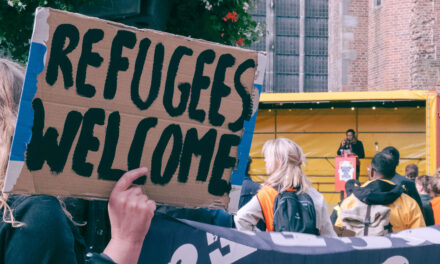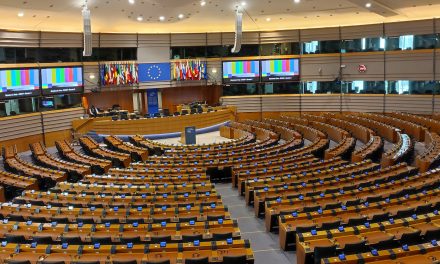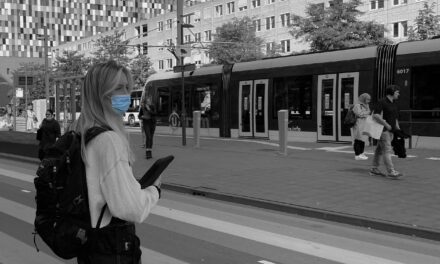After the fire in the refugee camp Moria on the Greek isle of Lesbos the European commission promised “No more Morias”. A few months later, the conditions in the provisional camp Kara Tepe are being criticized by countless NGOS. With a new European pact for migration on the distant horizon, there still seems to be no definite solution for the refugee camps on Europe’s borders.
It is a desperate call that comes from the Greek isle of Lesbos right before Christmas. While many people all over Europe are trying to figure out how many and which people they can visit over the holidays, over 7,000 refugees in the camp of Kara Tepe have only one wish: An improvement of their living conditions in their camp. After the overcrowded camp of Moria burned down September last year, they were transferred to this new camp. “Temporarily” they were told. Three months later, they are still there. Now, they have formulated an open letter to all Europeans and in particular to Ursula von der Leyen. In this letter, they are describing the horrific conditions in the camp and come to a harsh conclusion: “Animals in the European Union have more rights than we do.”

7,200 refugees are living in the new camp of Kara Tepe on Lesbos (December 2020). Each one represented by one point in the graphic. In the camp of Moria, there were 12,600.
What is being done right now?
According to Astrid Castelein, head of UNHCR on Lesbos, conditions in the camp are being gradually improved: “It is a site, which is not perfect yet, but there are improvements being made. You have to keep in mind that it is an emergency camp.”
Tents are being “winterized” with wooden floors and plastic sheets for isolation, as far as this is possible. Mid December constructions of a proper drainage system have began to prevent future flooding. However, this takes time as all tents have to be temporarily removed area-by-area to install the drainage. According to Astrid Castelein, there is access to toilets and hot showers for everyone, a claim that is disputed by organizations like Medicine sans Frontier.
In contrast to Moria, the new camp is not being classified as “overcrowded”. According to UNHCR, eight people are living in one tent, which is the norm for tents like these. The camp provides much more space for the asylum seekers and is more organized than Moria.
However, Astrid Castelein and UNHCR are urging EU-member states to show solidarity and relocate some of the inhabitants of the camp: “We are urging for comprehensive and human solutions to prevent future overcrowding. In January, Germany is taking around, 1,500 refugees and we are urging other countries to do the same.”
The European Commission has taken immediate steps as well. A permanently stationed task force was sent to the isle of Lesbos to collaborate with local authorities and organizations to improve conditions.
What are the perspectives for the future?
The camp Kara Tepe was set up as an emergency camp, as a temporary solution. The European Commission has signed, together with the Greek government, a Memorandum of Understanding. In this, both sites have committed to find a new location for a long-term camp on Lesbos. At the moment, there are a few locations being looked at and a decision is expected soon. The new location will not be relying on tents as shelter anymore, but, instead, containers will be used.
However, the new camp will not be ready before September this year. That means, that the “emergency short-term solution” Kara Tepe will be used for at least a whole year.
The New Pact on Asylum and Migration
The European Commission has proposed a New Pact on Asylum and Migration last September to tackle the humanitarian crisis on its outer borders and to speed up asylum processes.
One focus point is the faster processing of applications of asylum. For that, there are two different processes planned: After every refugee has taken part in a “screening” to assess their situation, applicants with lower chances for asylum will enter a “fast track process”, which is meant to last 12 weeks at maximum until a decision is made. Those with higher chances for asylum enter the regular process. Several NGOs, e.g. ProAsyl have criticized this plan heavily. According to ProAsyl, the plan would lead to asylum apllicants being kept in jail-like conditions, while their claim is assessed. Additionally, it is impossible, in their opinion, to make a complete assessment of the situation and hidden vulnerabilities of the refugees in the first screening, which eventually decides about the future of the applicant. The European Commission, on the other hand, insists that every application will be processed according to European law.
More European solidarity is also at the forefront of the new pact. Countries, which do not take any refugees, shall be taking more responsibility, e.g. with sending refugees back to their home countries or financial aid. This concept has also been heavily criticized as no real solution for more European solidarity.
The Commission had to take into consideration the different approaches to migration of all its member states and find some common ground. Ylva Johansson, European Commissioner for Home Affairs, has described the process as “finding something that nobody is happy with, but everybody can live with”.
Still, it is not even clear if the proposal will be signed into action by all member states and which changes will be made in the process.

An overview about the new processes of asylum on the European borders, according to the proposal of the New Deal for Migration and Asylum.
The humanitarian crisis on the outer borders of the European Union proves to be a long-lasting difficult challenge. But, while member states are fighting about every sentence of the proposal and the future approach to migration and asylum, people on the European borders have to sleep in tents during the winter, exposed to heavy wind and rain. The camp Kara Tepe was set up as an emergency camp but will be in action for at least a year.
The new pact aims at speeding processes up to prevent refugees from staying in the camp for several months but lacking European solidarity and national egoism will most likely cause this pact to be further delayed, changed and stripped down. Even if it will ever come into action is uncertain.
Without joined European action, we may see picture as those in the burning camp of Moria or the flooded camp in Kara Tepe for a long time.




